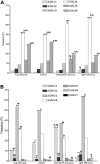High-throughput immunoglobulin repertoire analysis distinguishes between human IgM memory and switched memory B-cell populations
- PMID: 20457872
- PMCID: PMC2938129
- DOI: 10.1182/blood-2010-03-275859
High-throughput immunoglobulin repertoire analysis distinguishes between human IgM memory and switched memory B-cell populations
Abstract
B-cell receptor (BCR) diversity is achieved centrally by rearrangement of Variable, Diversity, and Joining genes, and peripherally by somatic hypermutation and class-switching of the rearranged genes. Peripheral B-cell populations are subject to both negative and positive selection events in the course of their development that have the potential to shape the BCR repertoire. The origin of IgM(+)IgD(+)CD27(+) (IgM memory) cells is controversial. It has been suggested that they may be a prediversified, antigen-independent, population of cells or that they are a population of cells that develop in response to T-independent antigens. Most recently, it was suggested that the majority of IgM memory cells are directly related to switched memory cells and are early emigrants from the germinal center reaction. Advances in sequencing technology have enabled us to undertake large scale IGH repertoire analysis of transitional, naive, IgM memory and switched memory B-cell populations. We find that the memory B-cell repertoires differ from the transitional and naive repertoires, and that the IgM memory repertoire is distinct from that of class-switched memory. Thus we conclude that a large proportion of IgM memory cells develop in response to different stimuli than for class-switched memory cell development.
Figures





Similar articles
-
Molecular footprints of a germinal center derivation of human IgM+(IgD+)CD27+ B cells and the dynamics of memory B cell generation.J Exp Med. 2009 Nov 23;206(12):2659-69. doi: 10.1084/jem.20091087. Epub 2009 Nov 16. J Exp Med. 2009. PMID: 19917772 Free PMC article.
-
Somatic diversification in the absence of antigen-driven responses is the hallmark of the IgM+ IgD+ CD27+ B cell repertoire in infants.J Exp Med. 2008 Jun 9;205(6):1331-42. doi: 10.1084/jem.20071555. Epub 2008 Jun 2. J Exp Med. 2008. PMID: 18519648 Free PMC article.
-
Human immunoglobulin (Ig)M+IgD+ peripheral blood B cells expressing the CD27 cell surface antigen carry somatically mutated variable region genes: CD27 as a general marker for somatically mutated (memory) B cells.J Exp Med. 1998 Nov 2;188(9):1679-89. doi: 10.1084/jem.188.9.1679. J Exp Med. 1998. PMID: 9802980 Free PMC article.
-
[Molecules involved in characteristics of naive/memory B cells].Nihon Rinsho Meneki Gakkai Kaishi. 2004 Oct;27(5):309-14. doi: 10.2177/jsci.27.309. Nihon Rinsho Meneki Gakkai Kaishi. 2004. PMID: 15559319 Review. Japanese.
-
Human IgM-expressing memory B cells.Front Immunol. 2023 Dec 8;14:1308378. doi: 10.3389/fimmu.2023.1308378. eCollection 2023. Front Immunol. 2023. PMID: 38143767 Free PMC article. Review.
Cited by
-
Memory persistence and differentiation into antibody-secreting cells accompanied by positive selection in longitudinal BCR repertoires.Elife. 2022 Sep 15;11:e79254. doi: 10.7554/eLife.79254. Elife. 2022. PMID: 36107479 Free PMC article.
-
High-throughput sequencing of B- and T-lymphocyte antigen receptors in hematology.Blood. 2013 Jul 4;122(1):19-22. doi: 10.1182/blood-2013-03-453142. Epub 2013 May 8. Blood. 2013. PMID: 23656731 Free PMC article.
-
Checkpoints for Autoreactive B Cells in the Peripheral Blood of Lupus Patients Assessed by Flow Cytometry.Arthritis Rheumatol. 2016 Sep;68(9):2210-20. doi: 10.1002/art.39710. Arthritis Rheumatol. 2016. PMID: 27059652 Free PMC article.
-
Immunoglobulin analysis tool: a novel tool for the analysis of human and mouse heavy and light chain transcripts.Front Immunol. 2012 Jun 28;3:176. doi: 10.3389/fimmu.2012.00176. eCollection 2012. Front Immunol. 2012. PMID: 22754554 Free PMC article.
-
Secondary mechanisms of diversification in the human antibody repertoire.Front Immunol. 2013 Mar 11;4:42. doi: 10.3389/fimmu.2013.00042. eCollection 2013. Front Immunol. 2013. PMID: 23483107 Free PMC article.
References
-
- Klein U, Kuppers R, Rajewsky K. Evidence for a large compartment of IgM-expressing memory B cells in humans. Blood. 1997;89(4):1288–1298. - PubMed
-
- Tangye SG, Good KL. Human IgM+CD27+ B cells: memory B cells or “memory” B cells? J Immunol. 2007;179(1):13–19. - PubMed
-
- Weill JC, Weller S, Reynaud CA. Human marginal zone B cells. Annu Rev Immunol. 2009;27:267–285. - PubMed
MeSH terms
Substances
LinkOut - more resources
Full Text Sources
Other Literature Sources
Research Materials

